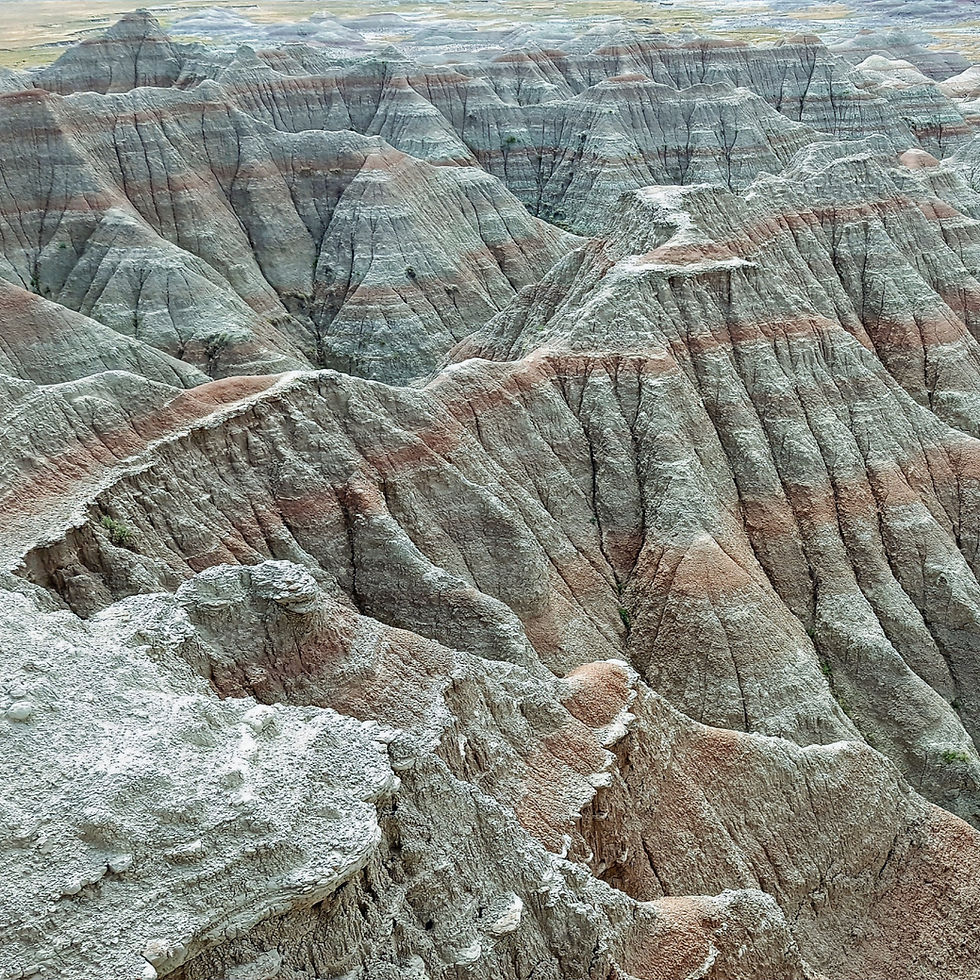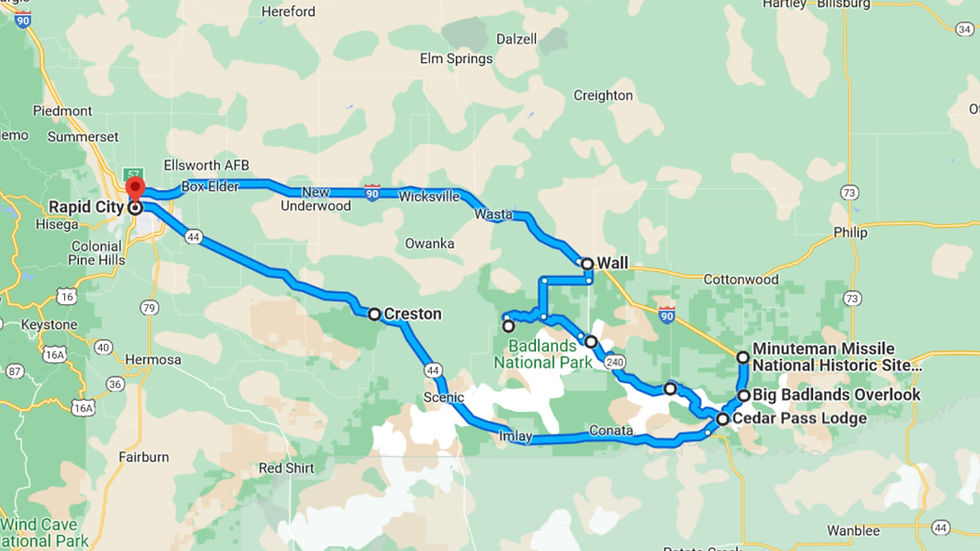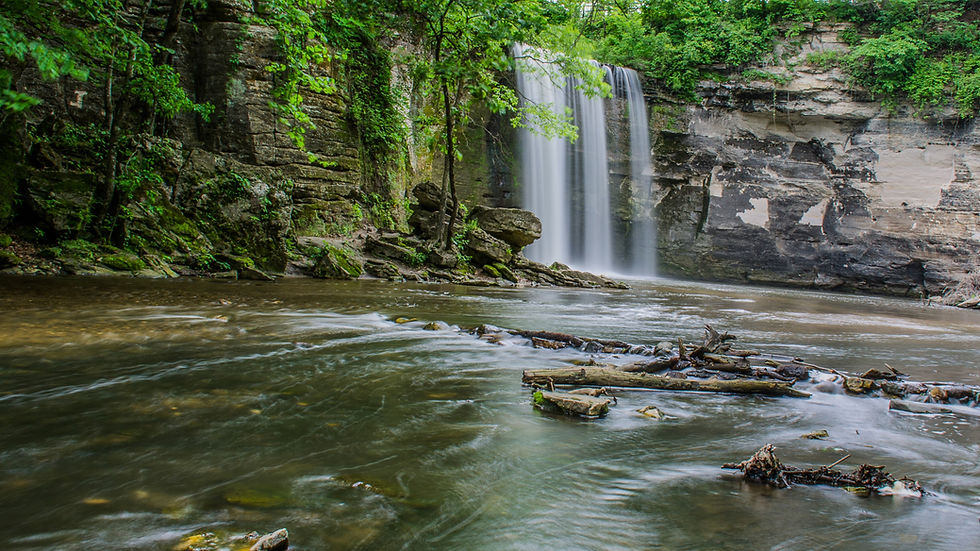South Dakota’s Badlands Make a Very Good Road Trip
- Greg Phillips
.JPG/v1/fill/w_320,h_320/file.jpg)
- Jul 13, 2025
- 4 min read
This byway is one of our choices for South Dakota’s Top Scenic Byways, as listed in our South Dakota section.

This road trip starts and ends in Rapid City. The actual Badlands Loop Scenic Byway only includes Badlands National Park but if you’re staying in the Rapid City area, it’s worth driving to the park via the southern route and then returning to Rapid City on the freeway. Start by heading east out of the city on South Dakota Highway 44. The southwestern part of the state boasts incredibly dynamic and diverse landscapes, and as you leave the forested foothills, the land changes to prairie. Some 30 miles from Rapid City, look to the north for the Creston Dinosaur, thought to be the first roadside dinosaur attraction in North America. Built in 1933 and then rehabbed in 1998, the dinosaur isn’t in great shape but still photo worthy.

Soon, SD 44 enters Buffalo Gap National Grassland. Though undeveloped, you can camp and look for bison, pronghorn, deer, prairie dogs, jackrabbits and a lot of birds. You’ll begin to see the jagged ridges of Badlands National Park appear across the prairie. The highway runs just north of the Pine Ridge Reservation, home to the Oglala Sioux Tribe. For something unique, tune into KILI 90.1 FM, the “Voice of the Lakota Nation,” which broadcasts many programs in the Lakota language.
About 73 miles from Rapid City, SD 44 arrives at Interior where you’ll then follow SD 377 northeast another two miles to Badlands National Park. Just passed the entrance, Cedar Pass Lodge has a campground, cabins and gift shop that sells Northern Plains Native artwork and crafts as well as regional and handmade gifts. The restaurant’s specialty is Famous Indian Tacos made with fresh fry bread.
Badlands National Park is a weirdly beautiful, out-of-place setting with colorful hills, buttes and ravines. Native Americans were first to call it "mako sica" or "bad lands." There are few trees or bushes. Instead grasses change shades from green to gold as seasons pass. It’s a geological playground, fashioned over millions of years. Sand, silt and clay were deposited in layers, forming sedimentary rocks. Then, erosion took over. For the last 500,000 years water and wind have transformed the flat floodplain and the process continues. One day, the Badlands will completely wear away, but since this erosion occurs at about one inch per year, it will take another 500,000 years.
Just beyond Cedar Pass Lodge is the Ben Reifel Visitor Center with exhibits, a bookstore and the Fossil Preparation Lab. This busy area is where the Badlands Loop Scenic Byway officially starts. Also designated SD 240, follow the highway another five miles north to the park’s Northeast Entrance. Along the way are several pullouts, hiking trails and overlooks.
Though it’s a bit of an interruption and definitely a stark contrast to the other attractions on this itinerary, it’s worth exiting the park and continuing four miles north on SD 240 to the Minuteman Missile National Historic Site. This Cold War relic is where two of 15 original Launch Control Facilities are preserved. From 1963 through the early 1990s crews maintained and controlled 150 silos holding Minuteman Intercontinental Ballistic Missiles. The adjacent visitor center has displays on nuclear deterrence and the Cold War.
From the missile site, return 8.5 miles south on SD 240 past Badlands National Park’s Northeast Entrance to the Ben Reifel Visitor Center. Then, continue on SD 240 west as it moves deeper into the park. From the visitor center it’s 22 miles to the Pinnacles Entrance on the western side. Along the route are numerous designated scenic overlooks and hiking trails, including the Fossil Exhibit Trail. The Badlands are home to one of the world’s richest fossil beds, evidence that the saber-toothed cat, rhino and horse were ancient mammals once living here.
About ½ mile before exiting the park via the Pinnacles Entrance, look for the gravel Sage Creek Rim Road to the left. It leads to the park’s other campground, Sage Creek, which is first-come, first-served with 22 sites. On the drive are several other viewpoints as well as the Roberts Prairie Dog Town, home of the park’s largest colony. Bison are best seen from Sage Creek Rim Road, too. Bighorn sheep are often spotted on rocky precipices at overlooks and if you’re really lucky, you might see a black-footed ferret at dusk or dawn. Once declared extinct, the species now thrives in Badlands National Park.
From Pinnacles Entrance, it’s eight miles north to Wall and the National Grasslands Visitor Center with exhibits and information on Buffalo Gap and several other restored prairies managed by the National Forest Service. Nearby, from a humble start in 1931 to today’s major tourist draw, Wall Drug sells everything from western wear, moccasins and jewelry to camping supplies and campy souvenirs. Or, just snap photos of your family posing with the six-foot rabbit, giant jackalope, buckin’ bronc or mini-Mount Rushmore. From Wall, it’s 55 miles west on I-90 to Rapid City.




Comments